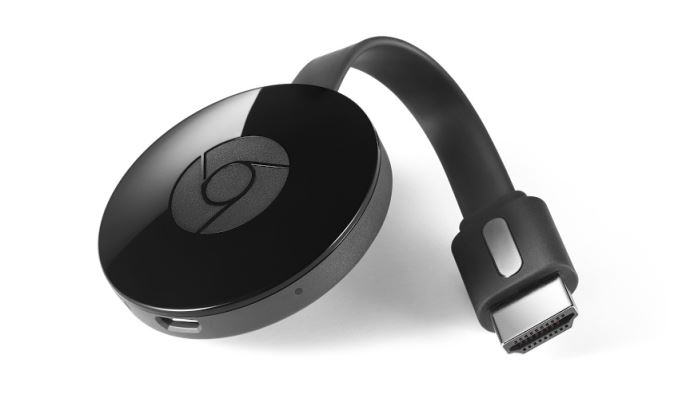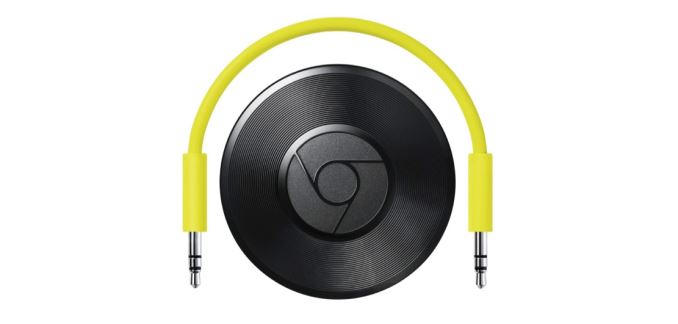Google Announces Chromecast (2) & Chromecast Audio
by Ryan Smith on September 29, 2015 6:30 PM EST- Posted in
- Mobile
- Media Player
- Smartphones
- Android
- Chromecast

Alongside today’s suite of Nexus phone announcements, Google also spent some time addressing the big screen with an update to the company’s family of Chromecast digital media player/receivers.
First off is the new, second generation Chromecast, which is simply being called the Chromecast. The update to Google’s original well-received player from 2013 doesn’t see a radical overhaul of the device, but does see Google making some significant changes where they need it most. On the networking side the Chromecast 2 has seen its WiFi radio upgraded from a single-band 2.4GHz 802.11n solution to a dual-band 2.4/5GHz 802.11ac solution, which should improve the overall bandwidth to the Chromecast while also making it a bit more apartment-friendly. Google’s presentation also notes that the Chromecast 2 uses multiple antennas to improve reception, presumably implementing antenna diversity.
| Google Chromecast Family | |||||
| Chromecast (1) | Chromecast (2) | Chromecast Audio | |||
| Processor | Marvell 88DE3005 SoC | N/A | N/A | ||
| Memory | 512MB | 512MB | N/A | ||
| Wireless | 2.4GHz 802.11n | 2.4GHz/5GHz 802.11ac | 2.4GHz/5GHz 802.11ac | ||
| Display Output | 1080p | 1080p | N/A | ||
| Max Video Decode | 1080p30 | 1080p | N/A | ||
| Ports | HDMI Micro-USB (Power) |
HDMI Micro-USB (Power) |
3.5mm Combo Jack (Analog + Optical Audio) Micro-USB (Power) |
||
| Launch Date | 07/24/2013 | 09/29/2015 | 09/29/2015 | ||
| Launch Price | $35 | $35 | $35 | ||
Meanwhile Google is staying mum on the rest of the internal electronics, besides providing broad guidance that the Chromecast 2 still supports “1080p” video. Given that they have published the RAM – 512MB – it’s entirely possible that this is the same Marvell chipset. What we do know is that the display output is still limited to 1080p; the bigger question is whether H.264 video decoding is still limited to 1080p30, or if 1080p60 is finally supported.
The physical form factor of the Chromecast has also been overhauled, doing away with the stick form factor of the original Chromecast for a more stand-alone ball in the shape of the Google Chrome ball. The new form factor in turn now includes an integrated HDMI cable, which is designed to fold against the ball when not in use. The shift in form factors is apparently driven in part by Google wanting to improve WiFi reception in concert with the changes they made above. The change also removes the need for a separate HDMI extender for the Chromecast, which was previously necessary in some cases on the stick form factor in order to plug it in to an HDMI port in a tight space.
Alongside the Chromecast 2, Google also announced a second Chromecast product, the Chromecast Audio. True to its name, the similarly ball shaped device is to audio what the Chromecast 2 is to video, functioning as a digital audio player and receiver. The Chromecast Audio is designed to be an additional audio source to be fed into existing sound systems, offering 3.5mm, RCA, or optical audio out to a speaker/receiver.
Google is pitching the Chromecast Audio as a more elegant solution to home audio streaming than Bluetooth, in large part by avoiding the pairing/range needs of Bluetooth, avoiding the need to keep a phone awake to stream, and leveraging Google’s existing media casting infrastructure. Meanwhile unlike its visual counterpart, as part of Google’s social aspirations the receiver also supports receiving audio from guests, allowing anyone in the area to send audio to a Chromecast Audio.
Both the Chromecast 2 and Chromecast Audio are being released immediately in 17 countries, and will retail for $35 each, the same price as the previous generation Chromecast.
Finally, along with the release of the new Chromecast hardware, Google is also updating the Chromecast software. Notable new features include a new Chromecast app for both Android and iOS which offers a more centralized interface for both selecting which Chromecast receiver to work with, and for interfacing with Chromecast-capable apps. The new Chromecast app can list all of the installed applications on a device capable of casting, making it much easier to identify which apps one can cast from. Meanwhile the company is also rolling out a new “fast play” feature, which uses predictive loading to attempt to speed up the loading process by predicting what media the Chromecast thinks a user may access next, and then pre-loading the start of that media so that playback can begin immediately. Given the normal amount of time required to suitably buffer an H.264 stream to start playing it, this could significantly shave off loading times, though a big part of its effectiveness will depend on the accuracy of Google’s prediction system.














23 Comments
View All Comments
jjj - Tuesday, September 29, 2015 - link
No 4k is rather surprising since that was the second most obvious upgrade (after wifi) and a given.The Audio is hugely overpriced considering the market it must address but ,honestly , even the Chromecast feels overpriced at 35$ now when little boards and sticks that are more capable are way cheaper.
Cygni - Tuesday, September 29, 2015 - link
Chromecast fills a few niches that many other streaming devices don't or cant. The ability to cast tabs, especially when streaming live video from the many sources that don't have a Roku/Apple TV app, is a daily use case in my house. That combined with the ability to stream local content effortlessly via Videostream has made me a believer.Yes, you can airplay Safari tabs or install Plex on a Roku, but neither are as simple and quick as the Chromecast. It's a bargain for $35 and I just picked up one of the new ones as the previous version was the last vestige of 2.4ghz networking in my house.
WinterCharm - Tuesday, September 29, 2015 - link
If you have an Apple TV any other set top box is useless thanks to AirPlay audio/video.Cygni - Tuesday, September 29, 2015 - link
I have an Apple TV, and AirPlay's compatibility with some live streams isn't great, especially when trying to fullscreen. Also it's support for local content streaming is the worst of the bunch. Also my Apple TV cost $99, the TWO Chromecasts I've purchased add up to $70.I haven't tried the new Apple TV yet, but it doesn't seem to address those issues.
r3loaded - Tuesday, September 29, 2015 - link
4K would have required a Tegra X1 and I don't think the Chromecast has the space, power or cooling for such an SoC. A shame really, because not only can the X1 decode 4K in hardware, it also supports hardware decoding of H.265 and VP9.Alexvrb - Wednesday, September 30, 2015 - link
Some of the Qualcomm chips also support hardware decoding of 4K HEVC steams, actually... and not just in the 8xx series. The more-affordable 620 and 618 also are capable - and space, heat, and power won't be an issue when you're talking about a smartphone SoC. :P There are other options out there too.Price was why they went with an el-cheapo SoC. If you want 4K you can get Amazon's Fire TV for $100. Oh, and Ryan? The Fire TV has had predictive pre-loading (they call it ASAP) long before Google. The voice search is a nice added bonus. Plus it's so easy even grandma could do it. Really if Roku wants to stay in the game their Roku 4 should be 4K HEVC capable and undercut Amazon by $20 or so.
Alexvrb - Wednesday, September 30, 2015 - link
Just to clarify, predictive buffering has indeed been available for about 1.5 years with the last-gen Fire TV, which is why I said they had it long before Google. As was voice search. But 4K UHD HEVC support is exclusive to the new 2015 model Fire TV which releases in a few days. So if you want a 4K steaming box to go with your new display, that's the one to get.quiksilvr - Monday, October 5, 2015 - link
I think it's UNDERpriced given the capabilities. Being able to cast my android screen to it in less than 3 seconds or playing full HD Netflix or YouTube instantly is a huge win. I can even cast my laptop browser to it at 720P with no issues and my laptop is a POS Pentium Dual Core from 2009 with single band wireless. What is cheaper than this that has the capabilities this has?HideOut - Tuesday, September 29, 2015 - link
hopefully router compatibility is better. Ive bought 3 and had 4 different routers. Never worked consistantly for me.cfenton - Tuesday, September 29, 2015 - link
It seems strange that these are two separate products. Couldn't they just add a 3.5mm output to the regular Chromecast?